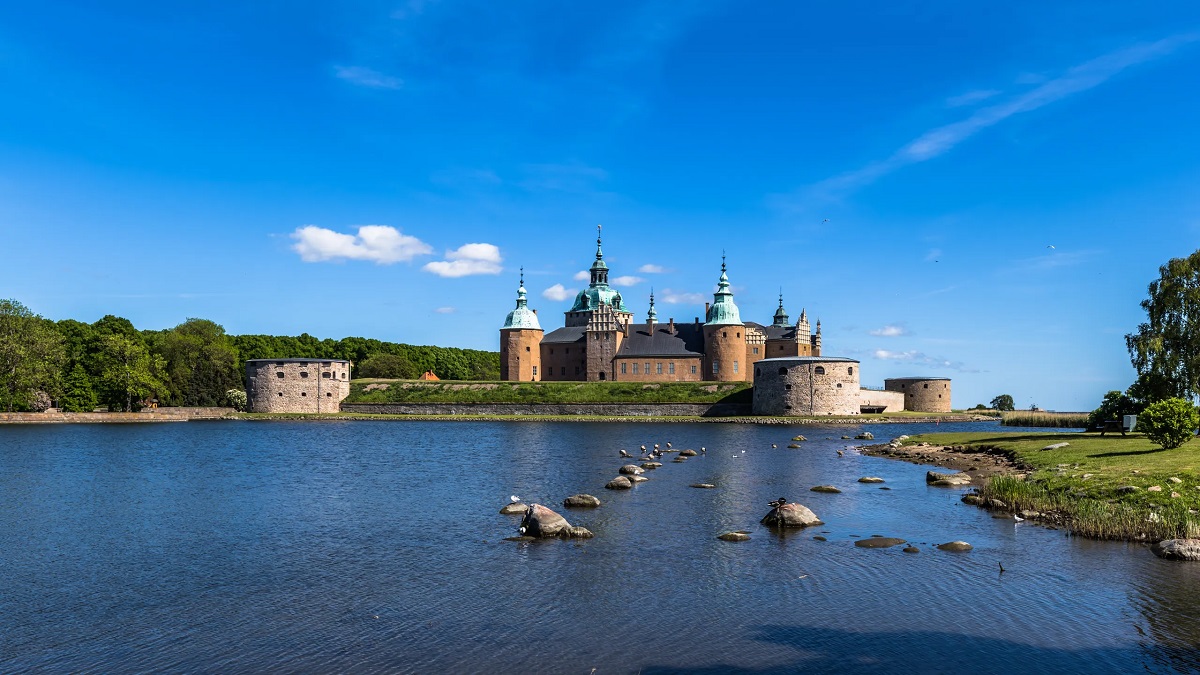Home>Weather and Climate>Exploring The Climate Of Sweden: Understanding Swedish Temperatures


Weather and Climate
Exploring The Climate Of Sweden: Understanding Swedish Temperatures
Published: March 1, 2024
Explore the weather and climate of Sweden, including the country's temperature patterns and climate characteristics. Gain insights into Swedish weather conditions and seasonal variations.
(Many of the links in this article redirect to a specific reviewed product. Your purchase of these products through affiliate links helps to generate commission for Temperatures.com, at no extra cost. Learn more)
Table of Contents
Introduction
Sweden, a captivating Nordic nation known for its stunning landscapes and rich cultural heritage, boasts a diverse climate that significantly influences the daily lives of its inhabitants. From the snow-covered landscapes of winter to the lush greenery of summer, Sweden experiences a wide range of temperatures and weather patterns throughout the year. Understanding the climate of Sweden is not only essential for residents and travelers but also holds significant importance in the context of global climate change.
In this comprehensive exploration, we will delve into the intricate details of Sweden's climate, shedding light on the factors that shape its temperatures, the historical climate trends, and the current challenges it faces. By gaining a deeper understanding of the climate in Sweden, we can appreciate the profound impact it has on the country's ecosystems, economy, and societal dynamics.
Join us on this enlightening journey as we unravel the mysteries of Swedish temperatures and weather patterns, gaining valuable insights into the captivating world of climate science and its real-world implications.
Read more: Sweden’s Winter Chill Depths Revealed
The Geography of Sweden
Nestled in Northern Europe, Sweden is a land of captivating contrasts, characterized by its diverse topography and natural beauty. The country spans over 1,500 kilometers from north to south, encompassing a wide array of geographical features that profoundly influence its climate. From the rugged mountains of the Scandinavian Peninsula to the picturesque coastline and expansive forests, Sweden's geography plays a pivotal role in shaping its weather patterns and temperatures.
The Scandinavian Mountains, also known as the Scandes, extend along Sweden's western border with Norway, forming a natural barrier that significantly impacts the climate of the region. These majestic mountains not only contribute to the country's stunning landscapes but also influence precipitation patterns and temperature variations. As moist air masses from the Atlantic Ocean collide with the mountainous terrain, they give rise to diverse microclimates, resulting in varying weather conditions across different parts of the country.
In addition to its mountainous regions, Sweden is adorned with an extensive coastline that stretches along the Baltic Sea and the Gulf of Bothnia. The proximity to these bodies of water exerts a moderating influence on the climate, leading to milder temperatures in coastal areas compared to inland regions. The maritime influence contributes to more temperate conditions, especially during the winter months, when the coastal areas experience less severe cold spells than the interior regions.
Furthermore, Sweden's vast forests, encompassing approximately 69% of the land area, play a crucial role in regulating the local climate. The dense foliage and expansive forest cover not only contribute to the country's renowned natural beauty but also influence temperature and humidity levels. The forests act as carbon sinks, absorbing greenhouse gases and mitigating the impact of climate change, thereby underscoring the intricate relationship between Sweden's geography and its environmental resilience.
In essence, the geography of Sweden, characterized by its mountains, coastline, and forests, serves as a cornerstone in understanding the country's climate dynamics. The interplay of these geographical elements creates a tapestry of climatic diversity, shaping the temperatures and weather patterns that define Sweden's atmospheric tapestry. This intricate relationship between geography and climate sets the stage for a captivating exploration of the four distinct seasons that grace the Swedish landscape.
The Four Seasons in Sweden
Sweden's climate is characterized by the presence of four distinct seasons, each offering a unique tapestry of natural beauty and atmospheric phenomena. From the crisp, snow-covered landscapes of winter to the vibrant blooms of spring and the sun-drenched days of summer, followed by the kaleidoscope of autumnal hues, the changing seasons paint a mesmerizing portrait of Sweden's climatic diversity.
Winter
Winter casts a spellbinding allure over Sweden, transforming the landscape into a winter wonderland adorned with glistening snow and ice. The season typically spans from December to February, bringing with it a serene blanket of snow that envelops the countryside. In the northern reaches of Sweden, the winter months are characterized by extended periods of darkness, as the mesmerizing spectacle of the Northern Lights graces the night skies. The temperatures during winter can plummet significantly, especially in the northern regions, where the mercury can dip well below freezing, creating ideal conditions for winter sports and activities.
Spring
As the grip of winter gradually loosens, Sweden awakens to the enchanting arrival of spring. From March to May, the country undergoes a remarkable transformation as nature bursts into life, with the emergence of vibrant blooms and the return of migratory birds. The temperatures begin to rise, and the landscape is adorned with a kaleidoscope of colors, marking the onset of a rejuvenating season. Spring in Sweden is a time of renewal and vitality, as the long-awaited warmth and sunlight breathe new life into the natural world.
Summer
Summer in Sweden is a time of boundless energy and endless daylight, characterized by long, sun-drenched days that extend well into the evening hours. From June to August, the country experiences a surge of warmth and sunshine, creating ideal conditions for outdoor pursuits and leisure activities. The Swedish countryside comes alive with lush greenery, and the pristine lakes and coastal areas beckon locals and visitors alike to bask in the natural splendor. The temperatures during summer are generally mild, with occasional heatwaves punctuating the season, providing a delightful contrast to the cool, refreshing waters that dot the landscape.
Autumn
As summer gradually yields to the embrace of autumn, Sweden undergoes a breathtaking transformation, as the lush greenery gives way to a symphony of golden hues. From September to November, the country is adorned with a mesmerizing tapestry of red, orange, and gold as the foliage undergoes a stunning metamorphosis. The temperatures begin to cool, and the crisp, invigorating air sets the stage for leisurely strolls amidst the resplendent autumnal scenery. Autumn in Sweden is a time of reflection and tranquility, as nature prepares for the arrival of winter, completing the captivating cycle of the four seasons.
In essence, the four seasons in Sweden offer a captivating glimpse into the country's climatic rhythms, each contributing to the rich tapestry of natural beauty and seasonal charm that defines the Swedish experience.
Factors Influencing Swedish Temperatures
The temperatures in Sweden are influenced by a myriad of factors, each playing a pivotal role in shaping the country's climatic patterns. These factors encompass a diverse range of geographical, meteorological, and environmental elements that collectively contribute to the dynamic nature of Swedish temperatures.
-
Latitude: Sweden's geographical location, spanning from approximately 55° to 69° N, exerts a profound influence on its temperatures. The country's proximity to the Arctic Circle results in significant variations in daylight hours throughout the year, with extended periods of darkness during winter and prolonged daylight during summer. This latitudinal effect contributes to the seasonal extremes in temperatures, with the northern regions experiencing colder winters and milder summers compared to the southern areas.
-
Maritime Influence: Sweden's extensive coastline and proximity to the Baltic Sea and the Gulf of Bothnia impart a maritime influence on its temperatures. Coastal areas benefit from the moderating effects of the sea, leading to milder winters and cooler summers compared to inland regions. The maritime influence also contributes to more stable and less extreme temperature fluctuations, creating a more temperate climate along the coastlines.
-
Topography: The diverse topography of Sweden, characterized by its mountains, forests, and plains, plays a crucial role in shaping temperatures across the country. The Scandinavian Mountains act as a barrier to air masses, influencing precipitation patterns and temperature differentials between the western and eastern regions. Additionally, the expansive forests contribute to localized climate effects, influencing humidity levels and temperature moderation.
-
Air Masses and Weather Systems: The interaction of air masses, including polar, continental, and maritime air, significantly impacts Swedish temperatures. The collision of these air masses gives rise to diverse weather patterns, leading to fluctuations in temperatures and precipitation. The movement of weather systems across the country contributes to the seasonal variability in temperatures, shaping the climatic conditions experienced in different parts of Sweden.
-
Global Climate Patterns: Sweden's temperatures are also influenced by global climate phenomena, such as the North Atlantic Oscillation (NAO) and the Arctic Oscillation (AO). These large-scale climate patterns can impact the strength and trajectory of air masses, leading to fluctuations in temperatures and weather conditions across the country.
In essence, the interplay of latitude, maritime influence, topography, air masses, and global climate patterns collectively shapes the intricate tapestry of Swedish temperatures, contributing to the captivating climatic diversity that defines the country's atmospheric dynamics.
Historical Climate Trends in Sweden
The historical climate trends in Sweden provide valuable insights into the long-term patterns and fluctuations that have shaped the country's atmospheric dynamics. Over the centuries, Sweden has witnessed notable shifts in temperatures, precipitation, and weather phenomena, reflecting the intricate interplay of natural and anthropogenic influences on its climate.
One of the most significant historical climate trends in Sweden is the notable warming observed over the past century. Historical temperature records indicate a discernible increase in average temperatures, with the most pronounced warming observed during the latter half of the 20th century and continuing into the 21st century. This warming trend aligns with global climate patterns and is indicative of the far-reaching impacts of climate change on Sweden's environmental landscape.
In addition to rising temperatures, historical climate data also reveals shifts in precipitation patterns and extreme weather events. Sweden has experienced fluctuations in precipitation levels, with certain regions witnessing changes in seasonal rainfall and snowfall patterns. These variations have implications for water resources, agricultural practices, and ecosystem dynamics, underscoring the multifaceted impacts of historical climate trends on the country's socio-economic fabric.
Furthermore, historical climate trends in Sweden have highlighted the vulnerability of certain ecosystems and species to changing climatic conditions. The warming temperatures have led to shifts in the distribution and behavior of flora and fauna, impacting biodiversity and ecological equilibrium. Additionally, the historical trends in extreme weather events, such as heatwaves and intense storms, have raised concerns about the resilience of infrastructure and the adaptive capacity of communities in the face of evolving climate risks.
The historical climate trends in Sweden serve as a testament to the intricate relationship between human activities and environmental dynamics. While natural climate variability plays a significant role in shaping historical trends, the influence of human-induced factors, including greenhouse gas emissions and land-use changes, cannot be overlooked. The historical climate data underscores the imperative of proactive climate action and sustainable practices to mitigate the impacts of climate change and safeguard Sweden's natural heritage for future generations.
In essence, the historical climate trends in Sweden offer a compelling narrative of the country's climatic evolution, highlighting the need for informed policies and collective efforts to address the challenges posed by a changing climate landscape.
Current Climate Challenges in Sweden
Sweden, like many nations around the world, is confronted with a myriad of pressing climate challenges that necessitate proactive measures and concerted efforts to mitigate their far-reaching impacts. From the specter of rising temperatures and changing precipitation patterns to the escalating risks posed by extreme weather events, Sweden grapples with a complex array of climate-related challenges that demand urgent attention and innovative solutions.
One of the foremost climate challenges facing Sweden is the escalating threat of climate change-induced impacts on the country's natural ecosystems and biodiversity. The warming temperatures and altered precipitation patterns have the potential to disrupt delicate ecological balances, leading to shifts in species distributions, habitat degradation, and heightened vulnerability of certain flora and fauna. These climate-induced perturbations pose significant challenges for conservation efforts and necessitate adaptive strategies to safeguard Sweden's rich biodiversity and ecological resilience.
In addition to ecological concerns, Sweden faces the imperative of addressing the impacts of climate change on its agricultural sector and food security. The changing climate patterns, including variations in rainfall and temperature extremes, can significantly impact agricultural productivity and crop yields, posing challenges for farmers and food producers. Furthermore, the heightened risks of droughts and heatwaves underscore the need for resilient agricultural practices and sustainable water management strategies to mitigate the impacts of a changing climate on food production and supply chains.
Moreover, Sweden grapples with the increasing frequency and intensity of extreme weather events, including heatwaves, storms, and flooding, which pose significant risks to infrastructure, public safety, and societal well-being. The heightened vulnerabilities associated with extreme weather events necessitate robust adaptation measures, resilient infrastructure development, and effective disaster risk management to enhance the country's capacity to withstand and recover from climate-related shocks.
Furthermore, Sweden is confronted with the imperative of transitioning towards a low-carbon, sustainable energy landscape to mitigate the impacts of climate change and reduce greenhouse gas emissions. The need to accelerate the shift towards renewable energy sources, enhance energy efficiency, and promote sustainable transportation infrastructure underscores the multifaceted nature of Sweden's climate challenges and the imperative of embracing innovative solutions to foster a greener, more resilient future.
In essence, the current climate challenges in Sweden underscore the imperative of proactive climate action, sustainable resource management, and collaborative initiatives to address the multifaceted impacts of a changing climate. By embracing a holistic approach to climate resilience and sustainability, Sweden can navigate the complexities of its climate challenges and pave the way for a more resilient, environmentally conscious future.
Conclusion
In conclusion, the climate of Sweden embodies a captivating tapestry of natural beauty, seasonal diversity, and climatic intricacies that reflect the profound interplay of geographical, meteorological, and environmental factors. From the majestic mountains of the Scandinavian Peninsula to the picturesque coastline and expansive forests, Sweden's geography serves as a cornerstone in shaping its atmospheric dynamics, influencing temperatures, precipitation patterns, and seasonal variations.
The four distinct seasons, each offering a unique spectacle of natural wonders, encapsulate the captivating essence of Sweden's climatic rhythms. From the serene snowscapes of winter to the vibrant blooms of spring, the sun-drenched days of summer, and the resplendent autumnal hues, the changing seasons paint a mesmerizing portrait of Sweden's climatic diversity, enriching the country's cultural tapestry and societal dynamics.
The factors influencing Swedish temperatures, including latitude, maritime influence, topography, air masses, and global climate patterns, collectively contribute to the dynamic nature of the country's climate. These intricate elements shape the temperatures and weather patterns that define Sweden's atmospheric tapestry, underscoring the multifaceted influences that govern its climatic rhythms.
Furthermore, the historical climate trends in Sweden provide valuable insights into the long-term patterns and fluctuations that have shaped the country's atmospheric dynamics. The discernible warming trend, shifts in precipitation patterns, and the vulnerability of ecosystems and species underscore the far-reaching impacts of historical climate trends on Sweden's environmental landscape, highlighting the imperative of proactive climate action and sustainable practices.
Amidst the captivating allure of Sweden's climate, the country grapples with a myriad of pressing climate challenges, including the escalating impacts of climate change on natural ecosystems, agricultural productivity, food security, and the increasing frequency of extreme weather events. These challenges necessitate proactive measures, resilient adaptation strategies, and collaborative initiatives to mitigate the multifaceted impacts of a changing climate and foster a more resilient, environmentally conscious future.
In essence, the climate of Sweden embodies a captivating narrative of natural wonder, climatic diversity, and the imperative of embracing sustainable practices and proactive climate action to safeguard its rich environmental heritage for future generations. By gaining a deeper understanding of the climate of Sweden, we can appreciate the profound impact it has on the country's ecosystems, economy, and societal dynamics, underscoring the imperative of collective efforts to address the challenges posed by a changing climate landscape.













